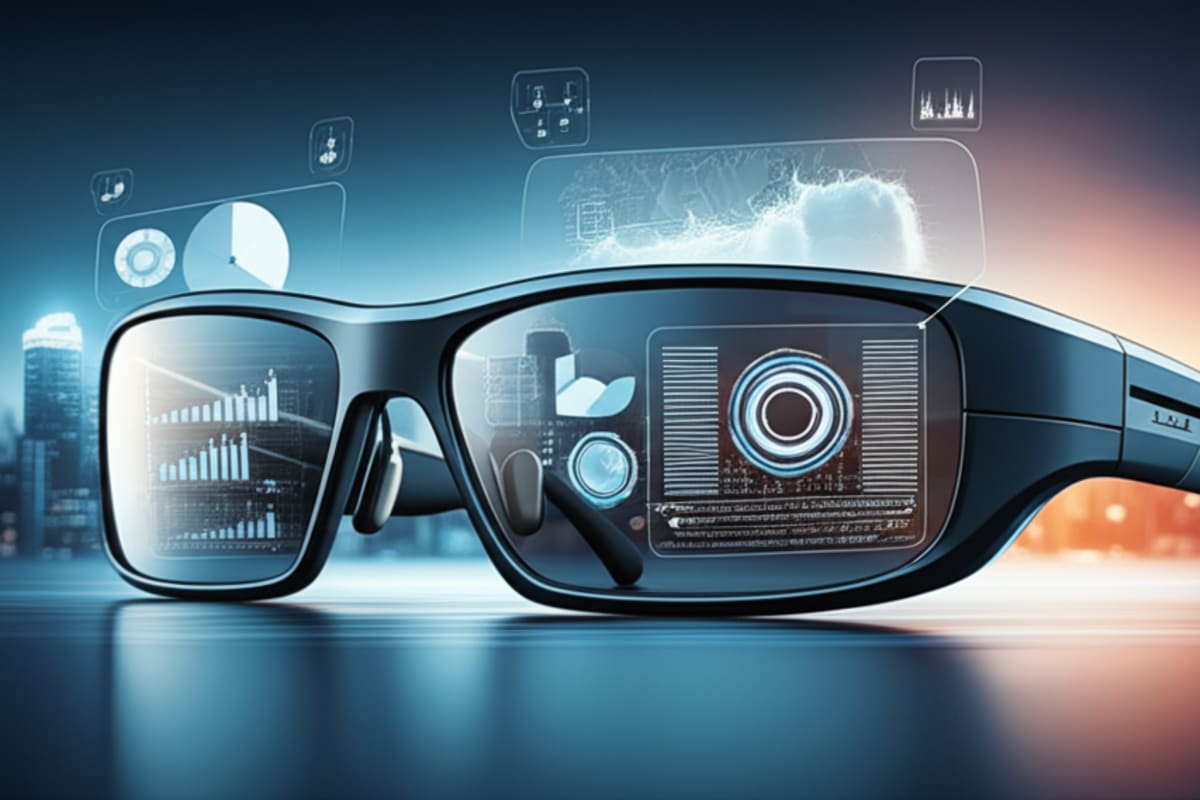Smart Glasses Race Heats Up: Meta Leads, Apple Accelerates AR Efforts

The Next Frontier: Smart Glasses Reshape Personal Computing
The wearable technology landscape is undergoing a significant transformation as the race for smart glasses dominance intensifies.
Background
What was once relegated to the realm of science fiction is rapidly becoming a tangible reality, with major tech players vying for a piece of what many believe will be the next ubiquitous computing platform, succeeding smartphones
Recent developments underscore the fierce competition, particularly between Meta and Apple, signaling a pivotal moment for augmented reality (AR) and wearable technology
This contest transcends a mere product category launch; it represents a strategic battle for the future of personal computing, aiming to move beyond the smartphone as the primary interface
The implications are profound, promising to reshape how we interact with digital information and the physical world, blurring the lines between the physical and digital realms
Meta's Early Lead with Ray-Ban Meta Glasses
A recent demonstration of Meta's latest offering, the Ray-Ban Meta smart glasses, revealed a notable advancement in discreet wearable technology.
Observers reported a seamless interaction with the glasses, where a display, virtually imperceptible to onlookers, allowed the wearer to engage with WhatsApp messages, utilize the glasses as a camera viewfinder, control music via intuitive gestures, and even navigate using maps
This 'monocular screen' integration into what appears to be an ordinary, albeit slightly bulkier, pair of Ray-Ban sunglasses was described as 'hugely impressive,' effectively blurring the distinction between everyday eyewear and advanced computing
Meta's Ray-Ban Meta glasses demonstrate significant progress in discreet smart eyewear, garnering positive initial impressions and demonstrating early market traction
These glasses represent a tangible step towards a future where digital information is seamlessly integrated into our daily lives
The success of the Ray-Ban Meta glasses, despite certain limitations imposed by the iOS ecosystem, highlights a clear consumer demand for such devices.
This early adoption positions Meta as a frontrunner in shaping consumer expectations for smart eyewear, allowing them to build a user base and refine their hardware as competitors prepare their own entries
Initial sales figures and user feedback suggest a growing comfort level with the concept of integrated cameras and displays in eyewear
Apple's Strategic Pivot Towards AR Glasses
The mere mention of an Apple-branded version of smart glasses ignites the imagination.
Imagine seamless integration with the vast Apple ecosystem – connecting effortlessly with iPhones, Apple Watches, and Macs – unlocking unparalleled utility and a user experience unmatched by competitors
Picture this: instant access to iMessages, photos, maps, and Apple Music, all displayed directly in your field of vision, or audio delivered through integrated spatial audio speakers, coupled with an eye-level camera for capturing moments hands-free
Apple's proven expertise in miniaturizing powerful hardware, as demonstrated by the Apple Watch and AirPods, suggests that their entry into this space could establish new benchmarks for design, performance, and user experience
Such a product, even initially positioned as a sophisticated iPhone extension, promises immense appeal to Apple's loyal and tech-savvy user base
Indeed, recent reports from Bloomberg confirm Apple's intensified focus on smart glasses, indicating a strategic shift in their development priorities
The company is reportedly pausing efforts on a lighter version of its high-end Vision Pro headset to accelerate the development of smart glasses, including both display-equipped and display-less variants. The latter, conceptualized as 'AirPods, but sunglasses,' could be an immediate hit, leveraging Apple's audio expertise and existing market dominance in the wireless earbuds category.
While the prospect of integrated cameras on facial wear naturally raises privacy concerns, the commercial success of the Ray-Ban Meta glasses, which also include cameras, indicates a viable market segment and a growing public acceptance of such features, particularly when coupled with clear privacy controls and responsible data usage policies
Timeline and Competitive Landscape
Despite the widespread anticipation, Apple's smart glasses may still be a few years away from widespread availability.
Initial reports suggest a potential announcement for non-display glasses as early as next year, with a launch potentially targeted for 2027
More advanced display-equipped glasses, initially slated for 2028, are now subject to this accelerated timeline, indicating the urgency Apple places on entering this market
Meta has already showcased its more advanced Orion augmented reality glasses, capable of overlaying virtual objects onto the real world, positioning them to potentially beat Apple to market with "true AR glasses
" Apple's historically successful "late-mover advantage" strategy will be put to the test
The competitive landscape extends beyond just Meta and Apple, highlighting the widespread interest in this burgeoning technology.
Samsung and Google are actively developing their own AR glasses, while smaller hardware companies are exploring innovative concepts and niche applications. Even former Apple design chief Jony Ive is reportedly involved in an AI glasses project for OpenAI, indicating a broader industry-wide push into intelligent wearables and a convergence of AI and wearable technologies.
This collective effort underscores the industry's widespread belief that smart glasses are poised to become the next major computing platform, transforming how we interact with technology and the world around us
Strategic Stakes: Why This Race Matters
For Meta, this substantial investment in smart glasses represents a strategic maneuver to disrupt the current smartphone-centric paradigm, specifically aimed at mitigating its reliance on platforms controlled by Apple
As CEO Mark Zuckerberg has stated, Meta aims to build its services without the limitations imposed by Apple's ecosystem, seeking greater autonomy in the next era of computing
Conversely, for Apple, entering the smart glasses market is crucial for preserving its dominance in personal computing and ensuring it doesn't miss the next significant technological revolution
The prevailing narrative suggests that Apple might be playing catch-up in both AI and smart glasses, areas where Meta appears to have an initial advantage
However, Apple's history offers a contrasting perspective
The company boasts a well-documented pattern of entering markets later than competitors but ultimately dominating them, as evidenced by the MP3 player (iPod) and the smartphone (iPhone)
This "late-mover advantage," coupled with Apple's brand recognition, renowned design capabilities, and robust ecosystem integration, could once again allow them to redefine the category, even if Meta pioneers the initial market and establishes early user adoption
Southeast Asia: A Key Market for Smart Glasses Adoption
The smart glasses race is a global phenomenon driven by the world's most influential technology companies.
For Southeast Asia, a region characterized by high smartphone penetration rates and a digitally native population, the adoption of smart glasses holds considerable potential
The region's youthful demographics and openness to new technologies make it an ideal testing ground and early adopter market for these devices
The success of smart glasses in a mobile-first region like Southeast Asia will depend on several key factors: seamless integration with existing devices and services, compelling and practical use cases that address specific needs, and accessible pricing that caters to diverse income levels
For consumers in bustling urban centers such as Singapore, Bangkok, or Jakarta, discreet smart glasses could offer a range of benefits:
- Enhanced Navigation: Hands-free, turn-by-turn directions overlaid directly onto the real world, eliminating the need to constantly check a phone screen.
- Instant Information Access: Quick and convenient retrieval of information, such as news, weather updates, or translations, without having to pull out a phone.
- New Forms of Entertainment: Immersive augmented reality experiences for gaming, media consumption, and interactive storytelling.
- Professional Utility: Tools for field workers, enabling remote assistance, data visualization, and enhanced communication in various industries, such as construction, logistics, and healthcare.
Developers in the region could find fertile ground for creating localized AR experiences, ranging from enhanced tourism guides showcasing historical landmarks to interactive educational content that brings learning to life, capitalizing on the region's high digital adoption rates and vibrant tech culture
The key will be ensuring that these devices offer genuine utility that transcends mere novelty, transforming them into an indispensable part of daily life, much like smartphones have already become
Conclusion: Defining the Next Era
This evolving technological frontier promises to fundamentally reshape how we interact with digital information and the physical world, ushering in a new era of interconnectedness and augmented experiences
The "smart glasses race" is far more than just a competition to create a new gadget; it's a battle to define the next era of personal computing, with profound implications for daily life, communication, and commerce on a global scale, including the digitally-savvy populations of Southeast Asia
The intensified competition between Meta and Apple underscores the fact that the market for smart eyewear is rapidly transitioning from a futuristic concept to mainstream adoption, driven by technological advancements and increasing consumer demand
The central question remains: will Apple's eventual offering live up to the playful moniker "iGlasses" and once again revolutionize a market it initially trails, or will Meta's head start enable it to solidify its position as the dominant force in this exciting new era of augmented reality and intelligent wearables
```